Sun 14 Dec 2014
Movie Reviews by David Vineyard: TREASURE OF THE AZTECS and PYRAMID OF THE SUN GOD (1965).
Posted by Steve under Action Adventure movies , Reviews[17] Comments
TREASURE OF THE AZTECS. CCC Filmkunst, West Germany, 1965. Originally released as Der Schatz der Azteken. Lex Barker, Gérard Barray, Rik Battaglia, Michèle Girardon, Alessandra Panaro, Theresa Lorca, Ralf Wolter, Jeff Corey. Based on a novel by Karl May. Director: Robert Siodmak.
PYRAMID OF THE SUN GOD. Originally released as Die Pyramide des Sonnengottes. Essentially the same credits as above. This is a single film released in two parts because of the length the way Fritz Lang did The Tiger of Eschnapur and The Indian Tomb in 1958. At heart it’s a serial with part one ending in a cliffhanger. But it isn’t two separate films, just one divided into two parts.
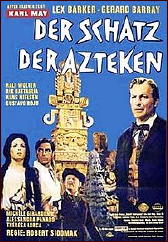
Likely you have never heard of this combined three hour epic western unless you are a fan of former Tarzan Lex Barker, German writer Karl May, noir director Robert Siodmak, screenwriter Ladislas Fodor, or German Westerns. Even then you may not have seen it because the only copies I know of are in German on YouTube.
Likely it is available in Region 2 format in German. My German is very bad, but this isn’t the type film with a great many long speeches or clever puns in it. I got by. You could get along pretty well with the sound turned off though you would miss the good score.
That’s not a knock, this one is actually quite a bit of fun if you accept it for what it is — a Technicolor wide screen serial anticipating Star Wars.
For those who don’t know, Karl May was a beloved German writer whose life included blindness, crime, and a redemption that led him to pen some of the most beloved works in German literature. He is best known for his works featuring noble Mescalero Apache chief Winnetou and his friend Old Surehand (aka Shatterhand and Firehand). Winnetou inspired so-called Indian clubs (like the Boy Scouts) all over Europe and May was the favorite writer of Albert Einstein, Albert Schweitzer, Hermann Hesse, and sad to say Adolf Hitler. May’s books are adventure stories but with a strong moral and Christian message, his most philosophical work being the allegorical novel Ardistan and Djinnistan.
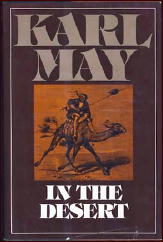
That one featured May’s other great hero, Kara Ben Nemsi, an adventurer in the Middle East, who features in five novels, beginning with In The Desert, that recount a journey to unveil a criminal conspiracy at the heart of the Ottoman Empire that starts with Kara Ben Nemsi finding a murdered man in the desert. Kara Ben Nemsi is his own Winnetou though he has a comic Arab side kick, Halef, and the comical English adventurer Sir David Lindsey in most adventures. Kara Ben Nemsi came to the screen as far back as 1920 and again in the 1950‘s. It was the early sixties before Winnetou made the leap to the big screen.
There have been several Winnitou films in the last decade, the most recent an animated version in 2009, Winnetoon (I don’t come up with them, I just report them). Kara Ben Nemsi has featured in at least two mini -series on German television.
May’s name in much of Europe was the equivalent of Jules Verne in terms of popularity and recognition. Other than Winnetou, whose cinematic adventures were often released in English with Pierre Brice in the title role and Rod Cameron, Stewart Granger, or Lex Barker as Old Surehand, it was the seventies before some of his other books came out in English here and Bantam attempted to do another Doc Savage with May’s work issuing uniform editions in paperback of Winnetou, Ardistan and Djinnistan, and In the Desert. One blurb described Kara Ben Nemsi as a cross between Superman, James Bond, and Jesus. (I thought it a bit tasteless too, but it is accurate.)
Even some May scholars aren’t sure if Old Sure Hand and Kara Ben Nemsi aren’t the same person with different names in different parts of the world. They might as well have been in the late 1960‘s because both, and Dr. Karl Sternau, the hero of these films, were being played by Lex Barker in big budget full color wide screen films. Online you can find Winnetou and In The Desert in e-book form rewritten with Old Surehand and Kara Ben Nemsi renamed Jack Hilyard in an attempt to fool American audiences. It didn’t work.

Sternau, the hero of this film is the physician to Otto von Bismark, who spent many years in Mexico and has many friends there. In the United States it is 1864, the Civil War is in full bloom, and diplomat Stenau is invited to visit the White House and President Lincoln (Jeff Corey the familiar American character actor and famed dialect coach).
Lincoln wishes to send a message of support to Mexican President Benito Juarez who is battling the French occupation of Mexico by the Emperor Maximilian backed by Louis Napoleon the Emperor of France and the French army (including the Foreign Legion though it is seldom mentioned in movies).
This much is true, Lincoln did support and sympathize with Juarez and did want the French off of this continent. Lincoln can offer Juarez nothing more than moral support because of the Civil War, but remarks to Dr. Stenau that it would aide the cause if Juarez supporters should unearth the lost treasure of the Aztecs.
Hold on, because it gets complicated from here.
Sternau travels to Mexico where he runs afoul of one of Juarez captains, a rogue Lazaro Verdoja (Rik Battaglia in a full blooded performance as the treacherous and lecherous villain). He is saved by Lt. Potaka (Gustavo Rojo) who takes him to Juarez (Fausto Tozzi). As a favor to Juarez Stenau agrees to visit wealthy ranchero owner Don Pedro Arbelez (Hans Neilson) and his daughter Rosita (Alessandro Panaro) and her companion and adopted sister, Karja (Theresa Lorca), unknown to everyone the true princess of the Aztecs and guardian of Montezuma’s treasure hidden in a live volcano as revealed to her by an ancient medicine man and the last true Aztec.
Along the way Sternau is aided by and ends up accompanied by Andreas Hassenfeffer (Rolf Walter) a traveling cuckoo salesman and the film’s comic relief (and you will need relief from him at times since his chief comic attribute is to talk incessantly) and joined by his friend American gunfighter Frank Wilson (Kelo Henderson) who falls quickly for Rosita when he saves her and Karja from hostile Indians (they don’t miss much in this one). Wilson plays with those guns to the point you may want to send him to Austria for a few sessions with Freud. He seems to find shooting at people’s feet amusing, though they do not seem to be laughing about it.
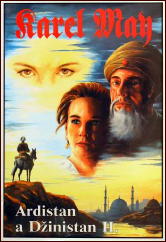
Onto the hacienda where Peroja makes a fool of himself with Rosita eventually trying to rape her and getting beaten up by Sternau just as Juarez arrives to banish him. But before that Sternau travels to Mexico City to meet Count Don Rodrigo de Rodriganda y Sevilla (Francis von Ledbedur — the real life count who played Queequeg in John Huston’s Moby Dick) and his playboy son Alfonso (Gerard Barray) fiancee of Karja.
Alfonso gets involved in a duel over a gambling debt, but his lover Josefa (Michele Giradon), an agent of French secret police leader Marshal Bazaine (Jean-Roger Caussimon), arranges for him to miss the duel and his father to go instead where he is fatally wounded.
The idea was for Alfonso to inherit the money and keep it from Juarez, but seeing what a useless playboy his son is the dying Count rewrites his will leaving the money to Juarez cause through Dr. Stenau.
We are still in part one. Still with me? I’m leaving out some minor actions scenes thrown in more to keep the film moving rather than move the plot along.
There are quite a few serial-like setbacks, advances, and adventures. Verdoja develops a hate for Sternau and Wilson, wants to to get the beautiful Rosita even more and turns mercenary for Bazaine and lover of Josefa. Alfonso betrays Sternau to Bazaine, but Hassenfeffer and Wilson save him, the little cuckoo clock salesman proving to be an excellent strategist — and in this film it is needed.
Eventually Sternau and Peroja struggle on the edge of the volcano, Sternau falls and is found by Karja and the medicine man who guides her. She insists the wounded man be taken in the treasure chamber where he briefly awakens, and she has to stop her mentor from killing him, asserting her true royal will. Instead a mystic smoke takes away his memory and heals him, and he is left to be found by Lt. Potaka as she chants her prayers to the towering gold statue of Montezuma (nothing phallic there).
End of part one and of the first book.
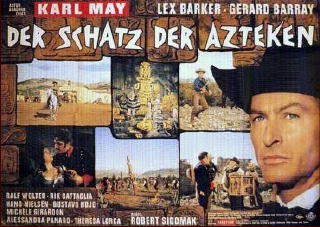
Pyramids of the Sun Gods starts with an impressive ten minute recap that somehow manages to hit the high points, and picks up with Sternau’s recovery as Potaka finds his body wrapped in a blanket among the bubbling fountains and flaming vents of the volcanic floor.
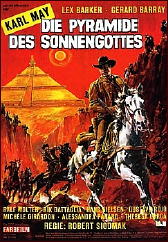
Verdoja has allied with the hostile Indians who also want Montezuma’s treasure and is having an affair with Josefa who has met her match. Meanwhile she introduces Alfonso to her scheming untrustworthy father so that just about everyone is lying to and cheating everyone else on that side of things including Verdoja and the chief of the Indians.
You won’t be able to watch this without thinking of Wagner in terms of plot and the plethora of treacherous characters all trying to stab each other in the back to the point it’s a wonder they don’t stab themselves in the back. The knife concession with this group could make you rich.
Meanwhile naive Karja tells Alfonso about Montezuma’s gold and he schemes to find it. Karja’s mentor punishes her when he learns of her mistake, but by now Alfonso has her medallion that shows the entrance to the treasure room. By now he has also double crossed Josefa’s father, who was busy double crossing her. He breaks into the volcanic hideaway and kills Karja, but not before she kills him. (It’s German, you have to expect this Wagnerian nonsense.)
That pretty much does away with the budding interest Potaka showed in her, but she never had eyes for anyone but Alfonso. Aztec princesses love a bad boy.
Back at the pyramids Verdoja and Josefa and the Indians are planning mischief and raid the hacienda killing Rosita’s father and capturing everyone else including her.
So let’s see. Lt. Potaka leads an attack on the pyramids; Verdoja threatens Rosita with a bed beneath descending spikes (I said this was serial-like) if she does not submit; a jealous Josefa comes upon them and dies under the spikes at Verdoja’s hand; the Indians who followed Alonzo return and Verdoja and the Indians leave his men in the lurch battling Potaka to steal the treasure; and Sternau, Hassenfeffer, and Wilson escape along with Josefa’s treacherous father who tells them of the treasure and where it is — he dies of course before it does him any good, it’s getting to the end and too many villains are still around to be picky — a bit like the last act of Hamlet.
Verdoja and the Indians find the treasure but as they gloat over the gold and begin to fight each other the old Indian lets loose the lava held back by a dam built by the Aztecs and it buries Verdoja alive with his gold as Sternau and the others, rather calmly all things considered, watch the volcano erupt taking its dead princess and the old medicine man and the secret of Montezuma’s gold.
I think I might have made a strategic retreat since it is entirely possible to look at the end of the film and think they are all blown to smithereens even though you know that was not the film makers’ intention.
At least I don’t think it was. Remember my German is sketchy at best.
Juarez would have to wait until 1867 to drive the French out and execute Maximilian, but he never did find the gold as you can tell by Mexico’s economic state in the years that have followed.
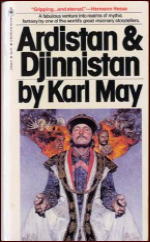
It’s just as well it ends here. Rik Battlagia’s Captain Verdoja was the most interesting and vital character, a brutal, nasty, and still rather attractive rogue compared to Barker’s stoic Dr. Sternau. I kept thinking what a good Doc Savage Barker would have made, Doc doesn’t show emotion either. He’s good in this, but his range of emotion is at best limited.
Okay, by limited I mean he smiles and frowns in the right places.
To be fair I think that was all they wanted him to do.
You’ll pardon me if I take a breath here.
I fully admit this is disjointed and confused as it sounds at times. The scenes don’t always flow smoothly, and the logic is very much like the silent German serials such as Joe May’s The Indian Tomb that inspired it. But Spain and Yugoslavia make a surprisingly good Mexico, the cinematography is first rate, the actors attractive, Barker a steadfast hero, Walter sometimes good comic relief, Lorca a busty but still young and nubile Indian princess, Giradon and Panaro attractive and good in their roles, and just about everyone acting as if they know exactly how much this was costing to make. Barker got $120,000 for the Winnetou movie The Treasure of Silver Lake, so I assume he got twice that for these two about the same time.
No wonder Barker stayed in Europe. Even as Tarzan he was never the star here he was there, and anyway he was fluent in five languages and brought up rich and sophisticated. Besides he had to pay alimony for Lana Turner and Arlene Dahl somehow along with one other, a current one, and there was one who died. Whether Jane and Cheetah got anything or not his biography doesn’t say.

I’ve had a bit a fun at the expense of this, but its a big good-natured film, and like the shaggy dog it resembles its impossible not to want to scratch it behind the ears. It’s entertaining is the best you can say for it, but that ought to be more than enough and there was no time in the movie when I smiled or laughed that I felt I was being snarky about it — I was just participating and reacting the way the film makers wanted.
If you are expecting the Robert Siodmak of Phantom Lady or The Killers you won’t find him, instead this harkens back to his early days in German cinema when he, Lang, Wilder, and others were learning their way. I would be surprised to find he or anyone involved didn’t at least enjoy the concept. It also goes back to the silent epics when Lang and others made their films epic length because if more than one film played at the same theater the take at the box-office had to be shared.
I know this being in German will put many of you off, and if you don’t understand a little of the language it will be even more daunting, but everything you really need to enjoy this is in this review or the synopsis at IMDb. It’s not a thinking man’s picture with a great deal of subtext or ur-text. I can’t imagine the screenplay for the three hour film was more than ninety pages at most. Like a Republic serial or B Western, fight scenes, good ones, take up a good deal of the running time.
So enjoy.
Of course you’ll need three hours to spare …
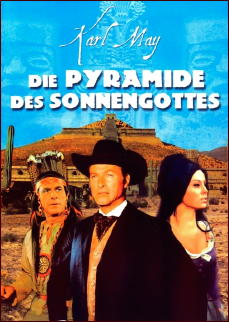
December 14th, 2014 at 6:45 pm
Many, many, many years ago I saw a film on television that was based on a Karl May book. Sorry, I can’t remember which film. I knew a little about Karl May so I recognized the credits. I used to encounter faculty members with European backgrounds at St. Olaf and when they heard I was interested in dime novels would tell me about Karl May. Somewhere I have a paperback translation or adaptation of a Karl May book.
Thanks for the memories, David.
December 14th, 2014 at 7:39 pm
The paperback I mentioned is WINNETOU, by Karl May. Bantam Books, 1980 English translation by Michael Shaw, published by the Seabury Press, 1977. First published in 1892. No, I haven’t read it. It’s over 700 pages long. That should not have deterred me though. Glancing through it the plot moves a lot faster than Cooper. That shouldn’t be a criticism of Cooper whom I have read and enjoyed. Maybe I’ll take a crack at it after the New Year.
December 14th, 2014 at 7:58 pm
I don’t remember ever seeing any of the Bantam editions of Karl May’s novels. I might not have bought them, but the cover image of one of them I included in David’s review ought to have caught my eye at least, but it didn’t, not back when Bantam put them out.
They, the Bantam editions, are easily obtainable, but the question now is, will I ever read them? I’ll have to think about that. Especially if they’re all 700 pages long.
December 14th, 2014 at 8:07 pm
While I was hunting down images to go with David’s review, I didn’t find many that came from the films themselves, but I did find a website that offers them for sale on DVD.
http://www.lovingtheclassics.com/by-title/p/pyramid-of-the-sun-god-1965.html
and
http://www.lovingtheclassics.com/the-treasure-of-the-aztecs-1965.html
It doesn’t say if the movies are dubbed, undubbed or subtitled, so if anyone is tempted, it might pay to ask. I used to buy public domain films from this seller, but not in the last four or five years.
December 14th, 2014 at 7:57 pm
There is currently an American publisher bringing out May’s work in trade paperbacks and e-book form (the latter reasonably priced). The translations aren’t bad and the books are often fun. I’m not sure whether these two have been translated yet or not.
Sorry about the multiple spellings of Verdoja, when I did the automatic correction when I finished this the laptop seems to have skipped a few.
All of the Kara Ben Nemsi books were released in uniform editions (with the hardcover Steve shows above of IN THE DESERT) with WINNETOU and ARDJISTAN AND DJINISTAN (allegorical to say the least, here Kara Ben Nemsi is also known as God’s Question in a John Bunyan like context), and those two with IN THE DESERT were issued as attractive mass market paperbacks by Bantam with exceptional cover art.
Even in translation though German lit can be heavy going, and May has never received the kind of exceptional translation some of Verne’s books have received in the last decade or so.
May was so poplar in Europe that even the Polish author of QUO VADIS wrote a children’s book in the May style and vein between his Teutonic Knights trilogy.
While little known here May still inspires adaptations on German and European television, most often Kara Ben Nemsi and often with big budgets and location filming.
Randy,
One of the Winnetou films, FLAMING FRONTIER I think, played in prime time on ABC in the sixties with Steward Granger and Elke Sommer starring along with Pierre Brice as Winnetou. Both it and TREASURE OF SILVER LAKE show up on Encore’s Western channel regularly, wide screen Technicolor epics. Barker stars in the latter with some excellent villainy by Herbert Lom who you don’t often see as an outlaw in a western. The first one is a bit stodgy for my tastes — settlers and wagon trains, Indians, land grabbers, cavalry, bad guys posing as Indians … TREASURE is much better with great scenery and location work and some spectacular gun battles and fights.
At least one other Barker film shows up in English, though as far as I know the Rod Cameron one never made it. I think there were two Granger Winnetou films making about five in the Brice series of which four and this can be found on YouTube, some of the former in English.
At least one series of the Kara Ben Nemsi miniseries is available on YouTube plus one of the Barker films in that series and three from the 1950’s and early sixties, one in black and white. I don’t know if the Barker Kara Ben Nemsi in English from Something Weird is the same as the one on YouTube or not.
They aren’t bad, Indiana Jonesish swashbucklers mixed with Arabian Nights ala Jon Hall and Maria Montez. It’s not all that hard to follow them whether you have any German or not. The films don’t really make much of the epic battle between Kara Ben Nemsi and the Ottoman conspiracy though the minis series does.
The books are very detailed both about the Middle East and American West. May was a prodigious researcher, and unlike Dumas not wont to stick in things like the ‘great African rattlesnake’ in Dumas GEORGES. In that May resembles Verne quite a bit though May is strongly Christian to Verne’s agnosticism or at least disinterest.
December 14th, 2014 at 8:12 pm
David
I’ve changed all of the Vergoja’s to Verdoja’s — or at least I think so.
December 14th, 2014 at 8:02 pm
Randy,
Evolution moves faster than Cooper. Like you I enjoy him, especially THE SPY and the sea novels (much better than Natty Bumpo), but glaciers have a faster pace. Twain, famously, loathed him.
Yes, that’s the Bantam books I mentioned.
December 14th, 2014 at 8:11 pm
When we were in Austria a good many years ago, I turned on the TV set in the room, and there was Stewart Granger in buckskins. Must have been one of the Winnetou movies.
December 14th, 2014 at 8:32 pm
Thanks Steve.
Bill,
Granger did do an American western, and in the VIRGINIAN, shown as movies in Europe, wore a fringe jacket, but likely it was one of the Winnetou films you saw him in. He had a distinctive way of holding that Winchester across his middle somewhat in the manner of Fess Parker as Davy or Dan’l, but with one hand.
Though May doesn’t say much about it Kara Ben Nemsi like Dr. Sternau and Old Surehand is German leading a number of people to think Nemsi and Surehand are the same person since they share so many traits.
Like Allan Quatermain May killed Winnetou off early on (the end of the first book), but like Quatermain it didn’t slow him down.
Steve,
While they aren’t slender, only Winnetou runs 700 pages, and it came out in serial form so there is no need to sit down and finish it in one sitting. IN THE DESERT is the one I would read of the three especially since it follows a criminal conspiracy and master criminal across the length and breadth of the Middle East.
Down the line I’ll review one of the movies in the Kara Ben Nemsi series.
December 14th, 2014 at 9:13 pm
David — THUNDER AT THE BORDER, starring Rod Cameron as Old Firehand, did have a dubbed U.S. release in the ’60s. A nice letterboxed print ran on GetTV a few months ago.
December 14th, 2014 at 9:52 pm
Fred.
Thanks, I had seen stills from the Cameron entry, but nothing else. Surehand, Shatterhand, and Firehand seem to be interchangeable names depending on the person doing the translation. I think that is the first of the Brice series.
Brice got so typecast as Winnetou it seems to have had some effect on his career though he did quite a bit else.
December 14th, 2014 at 10:09 pm
I think it was the Stewart Granger film that I saw.
December 14th, 2014 at 11:45 pm
IMDb claims ten Winnetou films with Brice and Barker which is clearly wrong since they don’t list that many. Brice would go on to appear as Winnetou in two German television series. The French born actor, who saw action in French Indochina, last listed screen appearance was in 2009.
Ironically, or not, he appeared in a peculiar Euro Spy movie called KILLER’S KARNIVAL with Stewart Granger and Lex Barker, which consists of a trio of short films (two spy and one LA pi with Barker) tied together by a narrator illustrating how dangerous the business is in the storytelling framework. The middle section featured Brice.
For anyone interested Kara Ben Nemsi means either Karl the German or Black bearded German (both references to Karl May who identified with both he and Surehand). The latter is ironic because Kara Ben Nemsi is pictured as a blonde in every film that I’ve seen dating back to 1936.
That other Barker Kara Ben Nemsi I was trying to recall is THE YELLOW ONE which has Kara Ben Nemsi hunting a sort of serial killer in Albania, the Schut. I think it is listed by Something Weird as THE SHOOT.
Ralf Wolter, who plays the comic relief in the two films reviewed appears as Hadji Halef, Kara Ben Nemsi’s comic Arab sidekick in both films, the comic relief role of Halif and Sir David true to the novels as well.
Randy,
I think the second Granger film is RAMPAGE AT APACHE WELLS, though you most likely saw the one with Elke Sommer, her presence one of the chief reasons it ran on ABC in prime time.
All of the Winnetou films from the sixties save the Cameron one have played on Encore’s Western channel.
December 15th, 2014 at 1:47 pm
It was so long ago that I have little memory of the film I saw. I don’t think it was in prime time and may have been a late night or Saturday afternoon airing. I may try to track it down some day.
December 18th, 2014 at 2:57 pm
For anyone still interested I have found a May (pronounced My) novel where it is clear Old Surehand and Kara Ben Nemsi are the same, since it opens with Winnetou and Old Sure hand in the West and then moved to the Middle East with K and Halef. Confusing since Dr. Sternau is also a Karl and may be yet a third. person of the same character — a bit like finding out Shadow with all the identities.
May 1st, 2021 at 2:17 am
The commentator achieved to miswrite three of his mentioned four big guys of German history: Albert Einstein (correct!), Albert Switzer (no! Schweitzer!), Herman Hesse (no! Hermann!) , Adolph Hitler (no! Adolf, but he was not a German, he was an Austrian).
May 1st, 2021 at 11:01 am
All corrections welcome, Romanus, and I’ve made all of them. Thanks! And doing so gave me the opportunity of fixing some other errors and adding the images back in. These were lost for about half the posts on this blog when it changed platforms a while back. The only way to replace them is manually, one at a time.